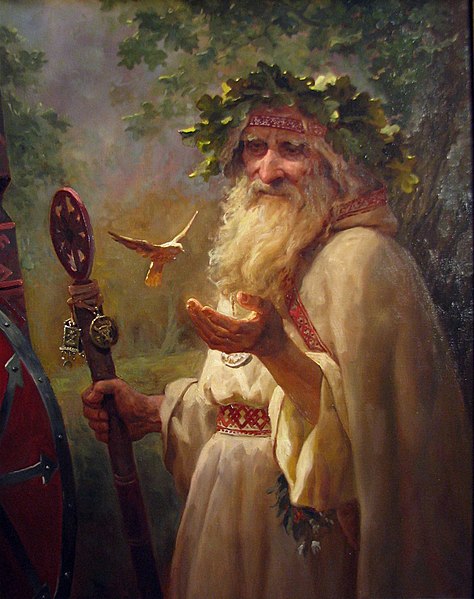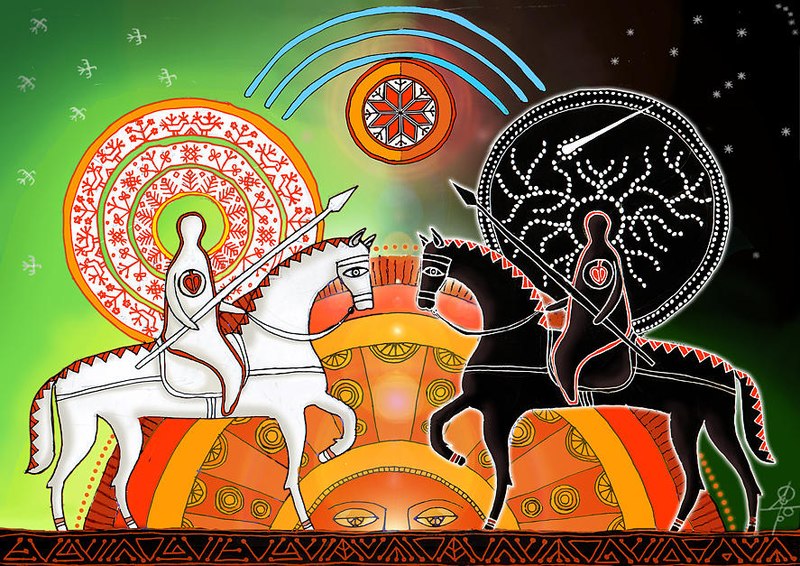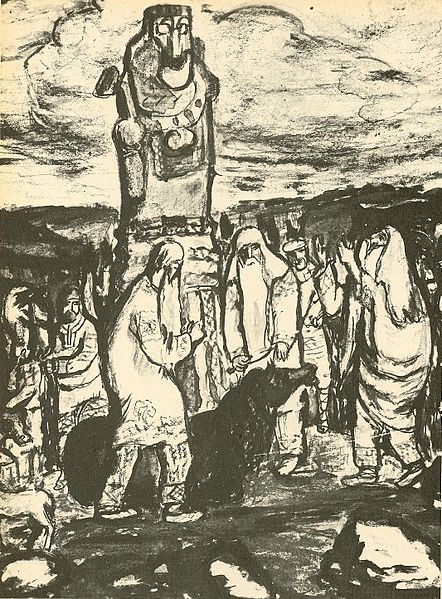Like every culture around the world, Slavs also have a history of practicing folk religions before their Christianization. Slavic Paganism is that folk religion that the Slavs were practicing.
Documentation of Slavic Paganism is a bit on a lacking side, but there has been reconstruction efforts that have been very prominent since the twentieth century as well as archaeological findings. Still, most of the on hand documentation we have about Slavic Paganism comes from Christians writing about them during interactions such as conversion efforts but there are also some chronicles and letopises that discuss things from Slavic Paganism.
Slavic Paganism has been related back to the idea of the Proto-Indo-European religion. It shows similarities to the Thracian, Balt, and Phrygian folk religions, and in the northern Slavic areas it shows similarities to the Finnic folk religions as well.
The writings that Christians gave of the old Slavs were not always very flattering. But this is understandable because the Christians were met with a substantial amount of resistance, especially from the volkhvs.

Who Were The Volkhvs?
A volkhv is a priest in Slavic Paganism. The word is directly translatable to sorcerer, wiseman, shaman, wizard, mage, and other related terms.
The volkhvs are written about as being among the Rus’ people, the people that would eventually become countries like Russia, Belarus, and Ukraine. When the Kievan Rus began to be converted to Christianity by interactions with the Byzantine Empire, the volkhvs in the areas of the Kievan Rus that are now Russia today put up great resistance.
There also exists a Volkhv divination book called the Volkhovnik. The Volkhovnik explains the divination meanings of different signs from an Old Russian interpretation.

The Gods of Slavic Paganism
In Slavic Paganism, there are many gods. Most gods are local, but there are also gods that appear commonly throughout the Slavic religion.
According to the Chronica Slavorum by the 12 century historian Helmold, the supreme god of the Slavic religion is Rod. Rod is the life-giver and the Slavic Pagans believe that from Rod came all other deities and all living beings.
Rod was also known by the name Deivos, meaning “god” or “deity,” and this name is a cognate to the Latin word Deus and other similar words from the Indo-European language family that have been used to classify a divine being. Rod’s name itself is a word meaning “guardian” or “keeper” but also has relations to “family” and “birth.”

One of the main ways that Rod is venerated is through ancestral worship. Rod is representative of male ancestors and the Rozhanitsy, spirit deities related to fate in Slavic Paganism, are representative of female ancestors. Rod and the Rozhanitsy also receive bloodless sacrifices, commonly bread, honey, cheese, and groat.
From Rod, a cosmic dualism emerged represented by two gods: Belobog and Chernobog. From the roots of Belobog and Chernobog emerged all of the masculine and feminine energies across Heaven and Earth and the deities that personified those energies.
Belobog and Chernobog appear to have some roots spreading out into various areas of Slavic culture, but in the documented eras they were most commonly followed by the western Slavs that lived between the Elbe River and the Vistula River. Belobog’s name means “White God” and Chernobog’s name means “Black God” and we can tell by their usage and folklore that the two were considered gods of luck, with Belobog being good luck and Chernobog being bad luck.

Belobog and Chernobog are also related to the sun and the moon, as Belobog is related to light while Chernobog is related to darkness. The deities beneath the two of them are called gods of waxing light and gods of waning light.
After Rod, Belobog, and Chernobog, the most important cult in Slavic Paganism was the cult promoted by the Great Prince Vladimir. Vladimir’s cult had five main deities, they were: Perun, Xors Dazhbog, Stribog, Simargl, and Mokosh.

Up until Vladimir converted to Christianity, this cult was worshipped at the temple on the hills outside of Kiev (modern day Kyiv). Beyond the cult center at Kiev, many local deities were worshipped alongside them in different Slavic communities.
The most prominent of the other Slavic deities that was not Rod, Belobog, Chernobog, or part of Vladimir’s pantheon is Veles. Veles is the Slavic god of the underworld, wealth, and horned livestock.

What Happened To Slavic Paganism?
From at least the 4th century onward, Slavic Paganism was dominant among Slavic speakers. Slavic inhabited lands near the Byzantine Empire began to be the first ones to be converted away to Christianity.
In 980 AD, the Great Prince Vladimir reformed Slavic Paganism’s cult to make it more organized and unified. However, just 8 years later, Vladimir and his officials were converted to Christianity.
While the western and southern lands of the Kievan Rus converted to Christianity a bit quickly, other lands such as the lands in present day Russia did not. In Russia, there is plenty of evidence suggesting the survival of paganism among the vast majority of the Russian population up until at least 1530 AD.
In the mid 16th century, the Russian Orthodox Church became more powerful and got more dedicated to “eradicating paganism” from Russia. However, evidence going into the late 19th century in Russia and Ukraine shows that the practicing of folk traditions and the minor belief circles in folk religion were still there.
In a lot of ways, the early years of Slavic churches saw them adopt quite a lot from Slavic Paganism. Examination of many things, even certain holidays that are, or were, practiced give evidence to pre-Christian origins.
The West Slavs resisted Christianization in the 11th century with uprisings. Germanization and the Northern Crusades eventually broke them down, but imprints on the traditions in the areas they inhabited are still observable today such as mountains and other landmarks named after figures and deities from Slavic Paganism.
Today, the Slavic Native Faith (Rodnovery) promotes Slavic Neopaganism in Russia. They have even revived the tradition of having volkhv.
Rodnovery in Russia connects itself both to Slavic Paganism and Russian Vedism. Russian Vedism, and by extension Rodnovery, consider themselves connected to Zoroastrianism and Vedic culture.